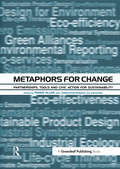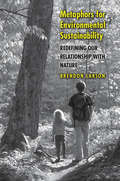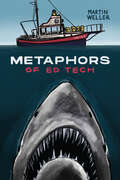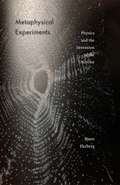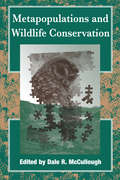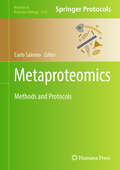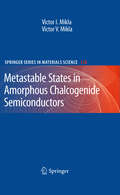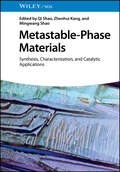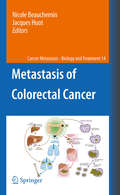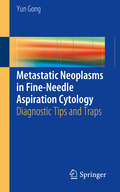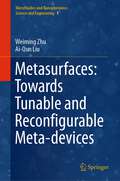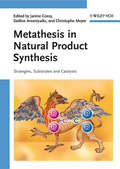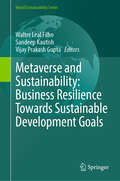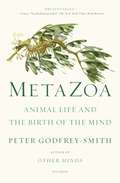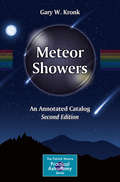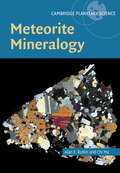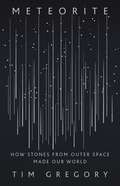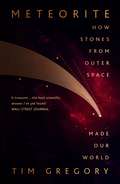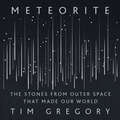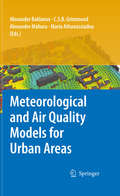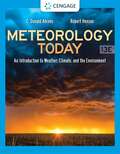- Table View
- List View
Metaphors for Change: Partnerships, Tools and Civic Action for Sustainability
by David Gee Penny Allen Christophe BonazziHow can we get from where we are to where we want to be? Metaphors for Change attempts to answer this question and provide a roadmap for sustainability by bringing together the thoughts of a unique collection of leading change agents from business, government and academia. Environmental questions have previously been dealt with metaphorically, by catastrophism or manicheism (zero growth; Malthusianism, Deep Ecology; "man is the enemy"; less is more). These metaphors have had limited impact because they have failed to connect with the mainstream of cultural, political, and business ideas. This book examines a number of new metaphors – and related partnerships, tools and action – which appear to have greater possibilities for the world in which we now live. The editors argue that Metaphors for Change can deliver to the public and to decision-makers new perceptions ("structured knowledge") that can help interpret the past and the present, and help us forge the future. The wider the gap between the "now" and the "necessary", the stronger the bridging perceptions have to be in order to break through barriers of fear and conservatism. Some of the concepts considered are: sustainable development; the polluter pays principle; the precautionary principle; eco-efficiency; eco-effectiveness; life-cycle assessment; design for the environment; eco-services; dematerialization; industrial symbiosis; industrial ecology; and zero emissions. There are of course other useful metaphors on the horizon, some of them included in this book. Including key contributions from the ground-breaking conferences ECO 97 and ECO 99, along with other specially commissioned and reprinted pieces, Metaphors for Change provides a treasure chest of new ideas, innovations and action. Accessible and forward-thinking, it will prove indispensable both as a student learning tool and as a panoramic overview of the sustainability metaphors key thinkers believe we should be putting into practice.
Metaphors for Environmental Sustainability: Redefining Our Relationship with Nature
by Brendon LarsonScientists turn to metaphors to formulate and explain scientific concepts, but an ill-considered metaphor can lead to social misunderstandings and counterproductive policies, Brendon Larson observes in this stimulating book. He explores how metaphors can entangle scientific facts with social values and warns that, particularly in the environmental realm, incautious metaphors can reinforce prevailing values that are inconsistent with desirable sustainability outcomes. Metaphors for Environmental Sustainabilitydraws on four case studies--two from nineteenth-century evolutionary science, and two from contemporary biodiversity science--to reveal how metaphors may shape the possibility of sustainability. Arguing that scientists must assume greater responsibility for their metaphors, and that the rest of us must become more critically aware of them, the author urges more critical reflection on the social dimensions and implications of metaphors while offering practical suggestions for choosing among alternative scientific metaphors.
Metaphors of Ed Tech (Issues in Distance Education)
by Martin WellerThe criticisms leveled at online education during the Covid-19 pandemic revealed not only a lack of understanding about how educational technology can be deployed effectively, but a lack of imagination. In this refreshing and insightful volume, Martin Weller provides new ways of thinking about educational technology through a wide range of metaphors. By using metaphors as a mental model, Weller enables educators to move beyond pragmatic concerns into more imaginative and playful uses of technology and to critically examine the appropriate implementation and adoption of ed tech.
Metaphysical Experiments: Physics and the Invention of the Universe (Posthumanities #49)
by Bjørn EkebergAn engaging critique of the science and metaphysics behind our understanding of the universe The James Webb Space Telescope, when launched in 2021, will be the premier orbital observatory, capable of studying every phase of the history of the universe, from the afterglow of the Big Bang to the formation of our solar system. Examining the theoretical basis for key experiments that have made this latest venture in astrophysics possible, Bjørn Ekeberg reveals that scientific cosmology actually operates in a twilight zone between the physical and metaphysical. Metaphysical Experiments explains how our current framework for understanding the universe, the Big Bang theory, is more determined by a deep faith in mathematical universality than empirical observation. Ekeberg draws on philosophical insights by Spinoza, Bergson, Heidegger, and Arendt; on the critical perspectives of Latour, Stengers, and Serres; and on cutting-edge physics research at the Large Hadron Collider, to show how the universe of modern physics was invented to reconcile a Christian metaphysical premise with a claim to the theoretical unification of nature.By focusing on the nonmathematical assumptions underlying some of the most significant events in modern science, Metaphysical Experiments offers a critical history of contemporary physics that demystifies such concepts as the universe, particles, singularity, gravity, blackbody radiation, the speed of light, wave/particle duality, natural constants, black holes, dark matter, and dark energy. Ekeberg&’s incisive reading of the metaphysical underpinnings of scientific cosmology offers an innovative account of how we understand our place in the universe.
Metapopulations and Wildlife Conservation
by Dale Richard Mccullough Jonathan Ballou Glen Woolfenden Bradley Stith F. Lance Craighead Bill PrantyDevelopment of rural landscapes is converting once-vast expanses of open space into pockets of habitat where wildlife populations exist in isolation from other members of their species. The central concept of metapopulation dynamics -- that a constellation of partially isolated patches can yield overall stability to a system that is chaotic at the level of the individual patch -- offers an important new way of thinking about the conservation and management of populations dispersed among small habitat fragments. This approach is proving to be a rich resource for biologists hoping to arrest the current catastrophic loss of biodiversity.This volume provides a comprehensive overview of the subject, addressing the needs of an applied professional audience for comprehensible information to integrate into their practices. Leading conservation biologists, ecologists, wildlife managers, and other experts consider the emergence and development of metapopulation theory and explore its applicability and usefulness to real-world conservation programs. Conservation is essential reading for anyone working in the field of wildlife conservation and management.
Metaproteomics: Methods and Protocols (Methods in Molecular Biology #2820)
by Carlo SalernoThis volume provides references for methods about the proteomics of microbial communities, also called metaproteomics. Chapters guide readers first through specific protein extractions from different environments and/or ecological niches crowded by heterogeneous microbial communities, then deepening the possible complete metaproteomic workflows in several situations or conditions. Written in the highly successful Methods in Molecular Biology series format, chapters include introductions to their respective topics, lists of the necessary materials and reagents, step-by-step, readily reproducible laboratory protocols, and key tips on troubleshooting and avoiding known pitfalls. Authoritative and cutting-edge, Metaproteomics: Methods and Protocols aims to ensure successful results in the further study of this vital field.
Metastable States in Amorphous Chalcogenide Semiconductors
by Victor V. Mikla Victor I. MiklaThis book addresses an interesting and technologically important class of materials, the amorphous chalcogenide semiconductors. Experimental results on the structural and electronic metastable states in Se-rich chalcogenides are presented. Special attention is paid to the states in the mobility gap and their sensitivity to various factors such as irradiation, annealing and composition. Photoinduced changes of structure and physical properties are also considered and structural transformation at photocrystallization is studied in detail. Finally, the authors discuss potential applications of the observed effects in xerography, digital radiography and for optical data storage.
Metastable-Phase Materials: Synthesis, Characterization, and Catalytic Applications
by Zhenhui Kang Qi Shao Mingwang ShaoDiscover the cutting-edge progress of a promising class of materials significant for use in energy technologies as catalysts Materials are said to be metastable-phases if they can retain their stability when subjected only to slight disturbances. Materials in metastable-phases can have very different properties from those in a state of equilibrium, and can perform very differently under conditions of experimentation, work, or industrial use. Metastable-phase materials are therefore a promising area of study in a variety of different fields, including cutting-edge industries. Metastable-Phase Materials constitute a wide-ranging overview of these materials, their properties, and their applications. Beginning with an overall characterization of metastable-phase materials and their normal modes of synthesis, it characterizes the most important branch of metastable-phase materials and reviews a range of catalytic applications. The result is a critical contribution to materials science and catalytic chemistry with potentially far-reaching implications. Metastable-Phase Materials readers will also find: Treatment of metastable-phase metal materials, 2D metastable-phase materials, and spin-dependent metastable-phase materials Detailed discussion of metastable-phase material applications in electrocatalysis, photocatalysis, thermalcatalysis, and more State-of-the-art technological applications in a myriad of areas Metastable-Phase Materials are ideal for materials scientists, catalytic chemists, inorganic chemists, photochemists, electrochemists, organic chemists, and the libraries that serve these communities.
Metastasis Research Protocols, 2nd Edition
by Udo Schumacher Susan A. Brooks Miriam DwekDiverse molecular, cellular, and environmental events must all come together to allow the successful formation of secondary cancers, metastases. The second edition of Metastasis Research Protocols, brings together the most up to date versions of the seminal techniques that were presented in the first edition and also includes new techniques that have recently been shown to be important in illuminating the processes underlying this important area of biology. Presented by top scientists, the collection includes a wide spectrum of articles encompassing important key methods and to introduce new methods which are making an impact in the area of metastasis research. Volume 1 includes key cellular and molecular techniques relevant to the exploration of cancer cells and tissues, the focus is on the tools that have been shown to be helpful in unravelling the molecular processes important in cancer metastasis. Written in the highly successful Methods in Molecular BiologyTM series format, chapters include introductions to their respective topics, lists of the necessary materials and reagents, step-by-step, readily reproducible laboratory protocols, and key tips on troubleshooting and avoiding known pitfalls. Authoritative and practical, Metastasis Research Protocols, Second Edition seeks to aid scientists in the further study of new methods in the area of metastasis research.
Metastasis of Colorectal Cancer
by Jacques Huot Nicole BeaucheminColorectal cancer is the third most common cancer worldwide, and in many parts of the western world, it is the second leading cause of cancer-related deaths. This book covers colon cancer metastasis from the most fundamental aspects to clinical practice. Major topics include physiopathology, genetic and epigenetic controls, cancer initiating cells, epithelial-mesenchymal transition, growth factors and signalling, cell adhesion, natures of liver metastasis, angiogenesis and lymphangiogenesis, inflammatory response, prognostic markers, sentinel node and staging, and finally diagnosis and treatment. Each chapter has been contributed by leaders in the field. A key feature is that it connects with a large readership including students, fundamentalists and clinicians. Another specific feature of the book is that the chapters are written in a didactic and illustrative fashion. These characteristics coupled with the choice of the topics and authors, makes this book a reference in the field. It represents an essential acquisition for medical libraries, clinicians as well as medical and graduate students.
Metastatic Neoplasms in Fine-Needle Aspiration Cytology
by Yun GongThis book focuses primarily on the most efficient way to make an accurate FNA diagnosis of metastatic tumors within the broad confines of cytopathology. The text provides a step-by-step "thought process" during the diagnostic approach of the metastatic tumors using detailed algorithms. Starting from the onsite immediate FNA sample assessment, the book provides strategy of specimen triage to facilitate further cytology evaluation based on the metastatic patterns and morphologic patterns of the tumors. In the subsequent chapter, the book provides tips and traps of selecting markers and interpretation of immunoperoxidase, flow cytometric, cytogenetic and molecular studies. The book includes the strategy of dealing with limited FNA material and wisely use existing samples (cell block, direct smear, cytospin) for different ancillary studies including molecular tests that have been used at MD Anderson. The author highlights challenging issues to show the importance of using a multidisciplinary (clinical, radiologic, cytologic and ancillary studies) approach. Extensive illustrations are provided. Metastatic Neoplasms in Fine-Needle Aspiration Cytology will provide pathology residents, fellows, practicing cytopathologists and cytotechnologists with a practical way to approach metastatic malignancies in daily cytology practice as well as provide a vision of the future of cytopathology.
Metasurface-driven Electronic Warfare
by Rafael Goncalves Licursi de MelloUnderstand the metasurface revolution in electronic warfare Electronic warfare (EW) ensures safe usage of the electromagnetic spectrum by one’s own forces while denying it to adversaries. Modern warfare is an extraordinarily fluid and dynamic activity, with numerous involved systems reconfigurable at the front or back ends. Metasurfaces, however, are artificially engineered surfaces that promise to take this dynamism to unprecedented levels by making platforms (aircraft, vessels, etc.) and the environment itself reconfigurable – a revolution that even major EW authorities have yet to fully comprehend. Metasurface-driven Electronic Warfare outlines the parameters of this revolution and its transformative potential in the EW space. Beginning with a historical overview of EW dynamism, it then provides the electromagnetic basics to understand metasurfaces, their operation mechanisms, and capacity for shaping electromagnetic waves. A series of detailed studies of metasurface applications in EW makes this an indispensable guide to an increasingly dynamic battlefield. Readers will also find: Clear cost-benefit analyses of metasurface substitutions in modern EW scenarios Detailed discussion of metasurface applications including stealth, electronic support, electronic attack, electronic protection, their use in drone swarms, smart environments, and more Simulations of EW scenarios with accompanying MATLAB codes and exercises Metasurface-driven Electronic Warfare is ideal for EW analysts, specialists, and operators, as well as signals intelligence and electrical engineering researchers and students. Because it covers the essentials in both areas, the book is also appropriate to support graduate courses on metasurfaces or EW.
Metasurfaces: Towards Tunable and Reconfigurable Meta-devices (Microfluidics and Nanophotonics: Science and Engineering #1)
by Ai-Qun Liu Weiming ZhuMetamaterials and metasurfaces are developing exciting new frontier researches on reconfigurable materials with promising applications on tunable and active devices. The combination of metamaterials and microsystems not only uncap the controllability limits of optical metamaterials, but also pave the way for vast applications. This book focuses on structural reconfiguration of metasurfaces and metamaterials using microsystems, which have previously been developed for tiny machines and droplets formations. It covers multi-disciplinary researches on reconfigurable metamaterials and metasurfaces revealing their potential applications on densely integrated devices with working frequencies ranging from GHz to infrared region. Topics like MEMS metamaterials, frequency selective surface, photonic reconfigurable metasurfaces, and microfluidic metamaterials are just a few examples, which present lively research communities within the scope of this book. This book is intended for undergraduate and graduate students who are interested in fundamental science and technology of micro-optics and artificial materials, researchers in the field of reconfigurable and tunable metamaterials, and engineers working on tunable lens, Lidar, beam steering devices, or other applications.
Metathesis in Natural Product Synthesis: Strategies, Substrates and Catalysts
by Stellios Arseniyadis Janine Cossy Christophe MeyerEmphasizing the impact of metathesis in natural product synthesis through the different types of key reactions, this is a comprehensive view of a hot topic. Written by top international authors, this ready reference is clearly structured and packed with important information, including representative experimental procedures for practical applications. A real must-have for anyone working in natural product synthesis.
Metaverse and Sustainability: Business Resilience Towards Sustainable Development Goals (World Sustainability Series)
by Walter Leal Filho Sandeep Kautish Vijay Prakash GuptaIn an era defined by rapid technological advancement and growing concerns over environmental sustainability, the intersection of the Metaverse and sustainable development presents both remarkable opportunities and formidable challenges. This book, "Metaverse and Sustainability: Business Resilience towards the Sustainable Development Goals", aims to explore this dynamic relationship and provide readers with insights into how businesses can leverage the Metaverse to not only thrive but also contribute positively towards the Sustainable Development Goals (SDGs). As the concept of the Metaverse evolves, it offers a digital realm where immersive experiences can reshape our interactions, economies, and even our perceptions of sustainability. It opens the door for innovative solutions that can transform traditional business models, making them more efficient, inclusive, and environmentally friendly. By harnessing the potential of virtual environments, organisations can engage stakeholders, reduce their carbon footprint, and promote sustainable practices in unprecedented ways. This book is structured to guide readers through the fundamental concepts of the Metaverse, its implications for various industries, and strategies that businesses can adopt to build resilience in face of sustainability challenges. Each chapter combines theoretical foundations with practical applications, case studies, and insights from industry leaders who are already paving the way towards a more sustainable future. As the world embarks on this journey through the synergy of the Metaverse and sustainability, this book show emerging technologies can serve as catalysts for positive change.
Metazoa - Morphologie und Evolution der vielzelligen Tiere: Ein Praxisbuch zum Zoologischen Praktikum
by Günter Purschke Achim PaululatDie vielzelligen Tiere - Metazoa - haben im Laufe der Evolution alle erdenklichen Lebensräume, die unsere Erde bietet, erfolgreich besiedelt. Ihre Körper vollbringen dabei Höchstleistungen, um unter oft widrigen Bedingungen zu überleben, zu wachsen und zur Reproduktion zu kommen. Stetig Nachkommen zeugen, Gene weitergeben und durch Mutationen Anpassungen an sich ändernde und neue Lebensräume erreichen, ist das Erfolgsgeheimnis der Evolution. Aber wie ist der Körper eines Tieres aufgebaut, um solche Leistungen zu erbringen? Welche Organe besitzen Tiere, wie nehmen sie ihre Umwelt wahr, und in welchem evolutionären Zusammenhang stehen die auf den ersten Blick so unterschiedlichen Organismen? Dies sind nur einige exemplarisch ausgewählte Fragen, die sich jede Biologiestudentin und jeder Biologiestudent am Anfang des Studiums stellt. Dieses Buch stellt die wichtigsten Baupläne ausgewählter Tiere vor und ist als modernes Praxisbuch konzipiert. Es soll allen Studierenden, die im Rahmen Ihrer zoologischen Ausbildung in experimentellen Übungen Tiere präparieren, helfen, die grundlegenden Körperformen und -strukturen, die in den jeweiligen Tiergruppen auftreten, zu erkennen und zu verstehen. Was sind die wichtigsten Merkmale, die Nematoden, Anneliden, Insekten usw. auszeichnet und jeweils zum evolutiven Erfolg dieser Tiergruppen beigetragen haben? Wo gibt es Gemeinsamkeiten und wo Unterschiede? Wie viele unterschiedliche Lösungen hat die Evolution für ein bestimmtes biologisches Problem gefunden? Die Vermittlung der Morphologie und Anatomie der Tiere, ihrer so genannten Grundbaupläne und der evolutiven Zusammenhänge ist das Ziel des vorliegenden Werkes. Dafür setzen die Autoren konsequent auf fokussierte kompakte Texte und Fotografien, die nicht nur die wichtigsten äußeren Merkmale der Tiere zeigen, sondern auch die Präparation Schritt für Schritt nachvollziehbar machen. Die Autoren wünschen sich, dass alle Biologiestudentinnen und -studenten mit Hilfe dieses neuen Buches erfolgreich ihr Zoologisches Praktikum bestehen werden, und neue Einblicke in die Morphologie und Evolution der Tiere gewinnen.
Metazoa: Animal Life and the Birth of the Mind
by Peter Godfrey-Smith"Enthralling . . . breathtaking . . . Metazoa brings an extraordinary and astute look at our own mind’s essential link to the animal world." —The New York Times Book ReviewThe scuba-diving philosopher who wrote Other Minds explores the origins of animal consciousnessDip below the ocean’s surface and you are soon confronted by forms of life that could not seem more foreign to our own: sea sponges, soft corals, and serpulid worms, whose rooted bodies, intricate geometry, and flower-like appendages are more reminiscent of plant life or even architecture than anything recognizably animal. Yet these creatures are our cousins. As fellow members of the animal kingdom—the Metazoa—they can teach us much about the evolutionary origins of not only our bodies, but also our minds.In his acclaimed 2016 book, Other Minds, the philosopher and scuba diver Peter Godfrey-Smith explored the mind of the octopus—the closest thing to an intelligent alien on Earth. In Metazoa, Godfrey-Smith expands his inquiry to animals at large, investigating the evolution of subjective experience with the assistance of far-flung species. As he delves into what it feels like to perceive and interact with the world as other life-forms do, Godfrey-Smith shows that the appearance of the animal body well over half a billion years ago was a profound innovation that set life upon a new path. In accessible, riveting prose, he charts the ways that subsequent evolutionary developments—eyes that track, for example, and bodies that move through and manipulate the environment—shaped the subjective lives of animals. Following the evolutionary paths of a glass sponge, soft coral, banded shrimp, octopus, and fish, then moving onto land and the world of insects, birds, and primates like ourselves, Metazoa gathers their stories together in a way that bridges the gap between mind and matter, addressing one of the most vexing philosophical problems: that of consciousness.Combining vivid animal encounters with philosophical reflections and the latest news from biology, Metazoa reveals that even in our high-tech, AI-driven times, there is no understanding our minds without understanding nerves, muscles, and active bodies. The story that results is as rich and vibrant as life itself.
Meteor Showers
by Gary W. KronkMeteor showers are among the most spectacular celestial events that may be observed by the naked eye, and have been the object of fascination throughout human history. In "Meteor Showers: An Annotated Catalog," the interested observer can access detailed research on over 100 annual and periodic meteor streams in order to capitalize on these majestic spectacles. Each meteor shower entry includes details of their discovery, important observations and orbits, and gives a full picture of duration, location in the sky, and expected hourly rates. Armed with a fuller understanding, the amateur observer can better view and appreciate the shower of their choice. The original book, published in 1988, has been updated with over 25 years of research in this new and improved edition. Almost every meteor shower study is expanded, with some original minor showers being dropped while new ones are added. The book also includes breakthroughs in the study of meteor showers, such as accurate predictions of outbursts as well as comet and meteor observations from the 6th century to the 17th century that were not published in the first edition. It holds all of the information needed to inspire a new observer or provide deeper knowledge to the long-time enthusiast.
Meteorite Mineralogy (Cambridge Planetary Science #26)
by Alan Rubin Chi MaMeteorites are fascinating cosmic visitors. Using accessible language, this book documents the history of mineralogy and meteorite research, summarizes the mineralogical characteristics of the myriad varieties of meteorites, and explains the mineralogical characteristics of Solar System bodies visited by spacecraft. Some of these bodies contain minerals that do not occur naturally on Earth or in meteorites. The book explains how to recognize different phases under the microscope and in back-scattered electron images. It summarizes the major ways in which meteoritic minerals form – from condensation in the expanding atmospheres of dying stars to crystallization in deep-seated magmas, from flash-melting in the solar nebula to weathering in the terrestrial environment. Containing spectacular back-scattered electron images, colour photographs of meteorite minerals, and with an accompanying online list of meteorite minerals, this book provides a useful resource for meteorite researchers, terrestrial mineralogists, cosmochemists and planetary scientists, as well as graduate students in these fields
Meteorite: How Stones from Outer Space Made Our World
by Tim GregoryExplore the universe and immerse yourself in the story of our solar system, planet, and life through meteorites.Meteorites have long been seen as portents of fate and messages from the gods, their fiery remains inspiring worship and giving rise to legends that have persisted for millennia. But beyond the lore, meteorites tell an even greater story: that of our solar system. In Meteorite, geologist Tim Gregory shows that beneath the charred crusts of these celestial stones lies a staggering diversity of rock types. Their unique constituents, vibrant colors, and pungent smells contain thrilling tales of interstellar clouds, condensing stardust, and the fiery collisions of entire worlds. Gregory explores the world of meteorites to uncover new insights into what our solar system was like before our sun became a star, into the forging of our planet, and into the emergence of life on it. Humans have long looked to the skies for answers to big questions. Meteorite reveals how science is finally arriving at those answers.
Meteorite: The Stones From Outer Space That Made Our World
by Tim GregoryEvery rock has a story tell, and none more so than those which have fallen from the sky: meteorites. Originating in the Asteroid Belt between Mars and Jupiter, these rocky fragments offer clues not just to the earliest origins of the Solar System but also to Earth's very survival into the future.Sky at Night presenter, Dr Tim Gregory takes us on a journey through the very earliest days of our Solar System to the spectacular meteorite falls that produced 'fiery rain' in 1792, to the pre-solar grains (literally stardust) that were blown in from other solar systems and are the oldest solid objects ever discovered on earth. Meteorites reveal a story much bigger than ourselves or our planet. As Tim says, 'it is an epic beyond compare'.
Meteorite: The Stones From Outer Space That Made Our World
by Tim Gregory'Drawing on his deep technical education and boundless curiosity, Tim Gregory brings a childlike wonder of discovery to everything he sees. He shows an uncanny ability to swiftly understand, to clearly explain, and to be joyful in the process. His scientific delight is contagious' Chris HadfieldEvery rock has a story tell, and none more so than those which have fallen from the sky: meteorites. Originating in the Asteroid Belt between Mars and Jupiter, these rocky fragments offer clues not just to the earliest origins of the Solar System but also to Earth's very survival into the future.Sky at Night presenter, Dr Tim Gregory takes us on a journey through the very earliest days of our Solar System to the spectacular meteorite falls that produced 'fiery rain' in 1792, to the pre-solar grains (literally stardust) that were blown in from other solar systems and are the oldest solid objects ever discovered on earth. Meteorites reveal a story much bigger than ourselves or our planet. As Tim says, 'it is an epic beyond compare'.(P) 2020 Hodder & Stoughton Ltd
Meteoroids: Sources of Meteors on Earth and Beyond (Cambridge Planetary Science #25)
by Galina O. Ryabova David J. Asher Margaret D. Campbell-BrownThis definitive guide provides advanced students and researchers with a detailed yet accessible overview of all of the central topics of meteor science. Leading figures from the field summarise their active research on themes ranging from the physical composition of meteoroids to the most recent optical and radar observations and ongoing theoretical developments. Crucial practical issues are also considered, such as the risk posed by meteoroids - to spacecraft, and on the ground - and future avenues of research are explored. Taking advantage of the latest dynamical models, insights are offered into meteor flight phenomena and the evolution of meteoroid streams and complexes, as well as describing the in-depth laboratory analysis of recovered material. The rapid rate of progress in twenty-first-century research makes this volume essential reading for anyone who wishes to understand how recent developments broaden our understanding of meteors, meteoroids and their origins.
Meteorological and Air Quality Models for Urban Areas
by Alexander Baklanov Maria Athanassiadou Sue Grimmond Alexander MahuraThis book for the first time gives an overall view of the current situation in urbanization of meteorological and air quality models around the world. It discusses and makes recommendations on the best practice and strategy for urbanization of different types of meteorological and air quality models. Based on the selected presentations given at the COST728 workshop, the contributions are arranged in four parts: urban morphology and databases; parameterizations of urban canopy; strategy for urbanization of different types of models; and evaluation and city case studies / field studies. The chapters treat either dynamic (on wind and turbulent) and thermal effects (on temperature and energy in general). The final chapter of this volume summarizes the discussion and conclusions from the four main topics and provides recommendations and future requirements. This monograph is oriented towards numerical weather prediction and air quality modelling communities.
Meteorology Today: An Introduction to Weather, Climate, and the Environment
by Robert Henson C. Donald AhrensNIMAC-sourced textbook
